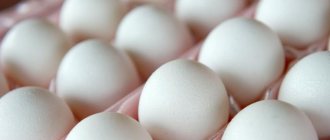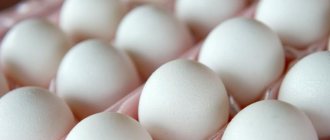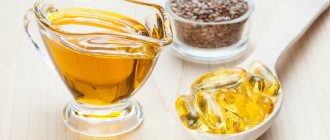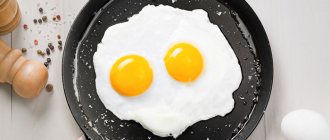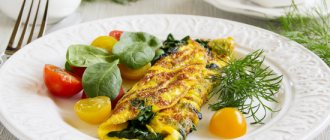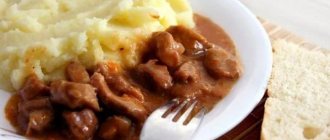Calorie content of fried egg without oil. Benefits of fried eggs without oil
- Vitamin A is responsible for normal development, reproductive function, skin and eye health, and maintaining immunity.
- Vitamin B2 is involved in redox reactions, helps to increase the color sensitivity of the visual analyzer and dark adaptation. Insufficient intake of vitamin B2 is accompanied by impaired condition of the skin, mucous membranes, and impaired light and twilight vision.
- Choline is part of lecithin, plays a role in the synthesis and metabolism of phospholipids in the liver, is a source of free methyl groups, and acts as a lipotropic factor.
- Vitamin B5 is involved in protein, fat, carbohydrate metabolism, cholesterol metabolism, the synthesis of a number of hormones, hemoglobin, promotes the absorption of amino acids and sugars in the intestines, and supports the function of the adrenal cortex. A lack of pantothenic acid can lead to damage to the skin and mucous membranes.
- Vitamin B12 plays an important role in the metabolism and transformation of amino acids. Folate and vitamin B12 are interconnected vitamins that are involved in hematopoiesis. A lack of vitamin B12 leads to the development of partial or secondary folate deficiency, as well as anemia, leukopenia, and thrombocytopenia.
- Vitamin D maintains calcium and phosphorus homeostasis and carries out the processes of bone tissue mineralization. A lack of vitamin D leads to impaired metabolism of calcium and phosphorus in the bones, increased demineralization of bone tissue, which leads to an increased risk of developing osteoporosis.
- Vitamin H is involved in the synthesis of fats, glycogen, and amino acid metabolism. Insufficient consumption of this vitamin can lead to disruption of the normal condition of the skin.
- Vitamin PP is involved in redox reactions of energy metabolism. Insufficient vitamin intake is accompanied by disruption of the normal condition of the skin, gastrointestinal tract and nervous system.
- Phosphorus takes part in many physiological processes, including energy metabolism, regulates acid-base balance, is part of phospholipids, nucleotides and nucleic acids, and is necessary for the mineralization of bones and teeth. Deficiency leads to anorexia, anemia, and rickets.
- Iron is part of proteins with various functions, including enzymes. Participates in the transport of electrons and oxygen, ensures the occurrence of redox reactions and activation of peroxidation. Insufficient consumption leads to hypochromic anemia, myoglobin deficiency atony of skeletal muscles, increased fatigue, myocardiopathy, and atrophic gastritis.
- Iodine is involved in the functioning of the thyroid gland, ensuring the formation of hormones (thyroxine and triiodothyronine). Necessary for the growth and differentiation of cells of all tissues of the human body, mitochondrial respiration, regulation of transmembrane transport of sodium and hormones. Insufficient intake leads to endemic goiter with hypothyroidism and slowing of metabolism, arterial hypotension, stunted growth and mental development in children.
- Cobalt is part of vitamin B12. Activates enzymes of fatty acid metabolism and folic acid metabolism.
Egg calorie content
Eggs are a tasty and filling food that can help with weight loss.
This dietary product is highly rated by professional chefs and healthy nutrition specialists. Information about the effect of eggs on the body and the rules for their consumption will help you get the maximum benefit from food. Information about the calorie content of dishes will allow you to create an optimal menu and normalize your weight.
Types of eggs and their calorie content
The popularity of the product is explained by its high taste characteristics and benefits for the body. In modern cooking, there are dozens of options for their preparation - from modest fried eggs to masterpieces of confectionery art.
Photo: adayinthekitchen.com
Eggs are easy to digest, and their chemical composition is rich in valuable elements and vitamins. This is one of the few components of the diet that is absorbed in almost 100% volume.
Several types of eggs are in demand among consumers:
- Chicken is a classic of the genre and a hit in the budget consumer basket. The nutritional value of 1 chicken egg in nutrition is equal to 100 g of meat. They are found with white and brown shells. The color of the shell matches the chicken's plumage. The average weight of 1 piece is 70 g.
- Quail eggs occupy 2nd place in terms of prevalence. They are fattier than chicken, but less allergenic. They are considered an environmentally friendly product, since poultry requires careful treatment and a thoughtful menu of harmless “chemicals”. The small egg is protected by a speckled shell and weighs about 17 g.
- Goose egg is a product with an expressive taste and powerful antioxidant properties. It is useful for strengthening the immune system and is actively used in cooking. Sold only at farmers' markets. The average weight of 1 copy is 200 g.
- Turkey eggs are similar in appearance and nutritional value to their chicken counterparts. The main difference is the higher fat content. Turkeys lay few eggs and seasonally, so their eggs are purchased individually by contacting the farmer-breeder. Weight of 1 piece – 70-72 g.
- Ostrich eggs are large exotic specimens. Giant size and bright taste are their key features. The weight of eggs depends on the breed of ostrich. A common indicator is 1600 g.
One ostrich egg can feed a company of 10 people.
Photo: quora.com
- Egg powder, or melange (from the French mélange - mixture) - dried and crushed whites and yolks of ordinary eggs. It is used for preparing dishes - omelettes, pastries, cutlets. The advantages of dry mixture over fresh eggs are a long shelf life and the absence of pathogenic microbes. During the processing process, whites and yolks are pasteurized.
Let’s figure out which egg is better, quail or chicken, together with Elena Malysheva in the “Live Healthy” program.
The energy value of eggs varies. The large size of the bird does not guarantee a high calorie content of the product. This is noticeable when comparing the calorie content per 100 grams and per 1 raw egg:
The number of calories consumed will depend on the amount of egg mass eaten. We invite you to familiarize yourself with it, which is good for your figure, health and is allowed for people with diabetes.
The exact content of proteins, fats and carbohydrates depends on the weight of the egg. Average values in grams:
White and yolk differ in composition and have different calorie content.
Photo: lifealth.com
Liquid protein takes up most of the egg (about 60%). The name of the component gives a clear idea of its composition. Egg white (protein) is a complex of compounds of the same name mixed with water that determine the nutritional value of the product. In the human body, protein performs a construction function and ensures the development of muscle tissue.
Egg protein contains a minimum of fat and has a low calorie content - 25 Kcal per 1 piece, or 60 Kcal per 100 g.
The yolk is half the size of the white. It contains more fat and has high energy value. The average calorie content of 1 piece is 75 Kcal, per 100 g – 375 Kcal.
The central part of the egg is a cluster of useful components. The composition of the yolk includes vitamins A, D, E, B, folic and nicotinic acid.
Among mineral substances, phosphorus and iron lead in quantity. Potassium, magnesium, calcium, zinc, and iodine are present in smaller volumes.
The uniqueness of eggs is explained by the presence of lecithin and niacin. These substances reduce the activity of bad cholesterol in the yolk and make the composition of the product as balanced as possible.
Beneficial features
The rich mineral composition of proteins and yolks explains their high nutritional value.
Egg protein is essential for muscle development and recovery.
Photo: toptengama.com
Due to their high content of vitamin A, phosphorus and iron, eggs help strengthen bones and teeth, increase the strength and elasticity of hair and nails.
Folic acid is responsible for the normal development of the fetus during pregnancy.
Calorie content per serving according to different recipes
When adding any components to scrambled eggs, you should remember that the energy value of the finished dish will directly depend on this. Some products can almost double this figure.
Popular recipes:
| Additional Ingredients | Amount per serving of two eggs, g | Cooking method | Kcal in finished portion |
| Bacon | 100 | Cut the bacon into thin strips, fry on both sides without oil; break the eggs, add salt to taste | 440 |
| Milk sausages (2 pcs.) | 110 | Cut the sausages into slices, fry in vegetable oil; pour in eggs, fry for 3-4 minutes | 510 |
| Tomatoes and onions | Tomatoes-95; onion - 50 | Fry the onion with sunflower oil until golden brown; add the tomatoes cut into pieces, simmer for 2-3 minutes, pour in the eggs (stir if desired) | 340 |
| Champignon mushrooms) | 75 | Cut the champignons, fry with vegetable oil for 3-5 minutes; pour in the beaten egg mixture, fry covered until done | 240 |
| Croutons (wheat bread) | 100 | Cut the bread into small cubes, fry for 1-2 minutes in sunflower oil; pour in the eggs, fry covered over low heat for 3-4 minutes | 575 |
| Cheese and greens | Russian cheese - 50; dill - 10 | Pour the beaten egg mixture into a heated frying pan; after 2 minutes add chopped dill and grated cheese | 420 |
Fried egg weight. How much does one egg weigh?
The weight of one raw chicken egg ranges from 40 to 80 grams, depending on the category.
How to determine the category of an egg? If the product is purchased in a store, then it will have a special marking stamp with complete information for buyers. For example, the smallest eggs weighing 40 grams belong to the third category. The weight range of the second category product is 45 – 55 grams. The first category includes eggs weighing 55 - 65 grams, and if the weight is a little more (65 - 75 grams) - this is already a selected product. The largest “giant” eggs weigh 75–80 grams and belong to the highest category.
European chicken eggs are slightly different in weight from eggs grown, for example, in Australia. If in the UK an egg weighing 53 - 63 grams is considered average, then to Australians such sizes may seem very large - in the homeland of the kangaroo, the eggs of the average category reach only 43 grams.
What determines the size and weight of chicken eggs? One of the main factors influencing egg parameters is the age of the hen. As a rule, the older the hen, the larger the eggs “get.” The weight of the bird and the size of the “final” product are interrelated - most likely, a large hen will lay larger eggs than a “slender” hen. Breed, quality of food, climate, time of year and day also have a significant impact on the size of the testicles.
This is interesting: the world's largest chicken egg, listed in the Guinness Book of Records, weighed 136 grams. The smallest egg weighs only 9.734 grams, and its “homeland” is Papua New Guinea.
Calorie content of fried eggs (1,2,3 pcs.)
100 grams of the product in its raw form contains 158 kcal. To grease a frying pan, you need at least 5 ml (teaspoon) of oil, which is 40 kcal.
Based on the specified parameters, it is easy to calculate the calorie content of the finished scrambled eggs:
| Chicken egg size | Raw (1 pc.) | Fried egg (calories 1 pc.) | Calorie content of scrambled eggs from 2 eggs | Calorie content of scrambled eggs from 3 eggs |
| Small (III category) | 75 | 105 | 190 | 265 |
| Secondary (I-II category) | 80-100 | 120-140 | 200-240 | 280-340 |
| Large (select and highest category) | 110 | 150 | 260 | 370 |
Omelet without oil calories. What are the benefits of Scrambled eggs - omelet without oil
- Vitamin A is responsible for normal development, reproductive function, skin and eye health, and maintaining immunity.
- Vitamin B2 is involved in redox reactions, helps to increase the color sensitivity of the visual analyzer and dark adaptation. Insufficient intake of vitamin B2 is accompanied by impaired condition of the skin, mucous membranes, and impaired light and twilight vision.
- Choline is part of lecithin, plays a role in the synthesis and metabolism of phospholipids in the liver, is a source of free methyl groups, and acts as a lipotropic factor.
- Vitamin B5 is involved in protein, fat, carbohydrate metabolism, cholesterol metabolism, the synthesis of a number of hormones, hemoglobin, promotes the absorption of amino acids and sugars in the intestines, and supports the function of the adrenal cortex. A lack of pantothenic acid can lead to damage to the skin and mucous membranes.
- Vitamin B12 plays an important role in the metabolism and transformation of amino acids. Folate and vitamin B12 are interconnected vitamins that are involved in hematopoiesis. A lack of vitamin B12 leads to the development of partial or secondary folate deficiency, as well as anemia, leukopenia, and thrombocytopenia.
- Vitamin D maintains calcium and phosphorus homeostasis and carries out the processes of bone tissue mineralization. A lack of vitamin D leads to impaired metabolism of calcium and phosphorus in the bones, increased demineralization of bone tissue, which leads to an increased risk of developing osteoporosis.
- Vitamin H is involved in the synthesis of fats, glycogen, and amino acid metabolism. Insufficient consumption of this vitamin can lead to disruption of the normal condition of the skin.
- Vitamin PP is involved in redox reactions of energy metabolism. Insufficient vitamin intake is accompanied by disruption of the normal condition of the skin, gastrointestinal tract and nervous system.
- Phosphorus takes part in many physiological processes, including energy metabolism, regulates acid-base balance, is part of phospholipids, nucleotides and nucleic acids, and is necessary for the mineralization of bones and teeth. Deficiency leads to anorexia, anemia, and rickets.
- Cobalt is part of vitamin B12. Activates enzymes of fatty acid metabolism and folic acid metabolism.
BZHU, composition
A chicken egg, regardless of weight, consists of 73% water. Proteins account for 13% of the mass, fats make up 12%, the remaining 2% are carbohydrates and mineral salts. The yolk is the most nutritious part. It is where most of the vitamins (A, D, E, F, K, PP, group B), microelements (phosphorus, calcium, iron, magnesium, etc.), polyunsaturated and saturated fatty acids are concentrated.
The bulk of the fat is also included in the yolk, so its energy value is three times higher than that of the white.

